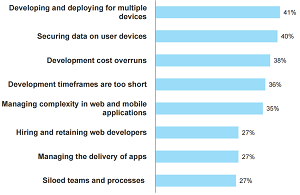News
Report: Swing from Native Development to Web in Mobile Arena
- By David Ramel
- June 15, 2015
Mobile Web app development tool vendor Sencha Inc. released research showing that many firms are turning to mobile Web app development tools at the expense of native approaches.
Sencha said it commissioned Forrester Consulting to conduct the independent research to see if customer trends it noticed about the swing from native to Web were actually occurring outside of its customer base, also.
"The study confirmed much of what we were hearing from our customers," exec Kristin Brennan said in a blog post last week. "Results showed that Web technology, as compared to native, is becoming increasingly critical to organizations' Web and mobile application strategies."
Among 120 senior technical leaders in North America and Western Europe surveyed by Forrester in March, "27 percent reported shifting away from native development to Web technology," Brennan said. "Companies are increasingly selecting Web technology over native to improve development efficiency and 'do more with less' by building apps with greater sophistication and complexity in the same amount of time."
While this new research clashes with many reports that indicate native -- or hybrid -- development has been gaining favor because of performance considerations, access to native device functionality and truly native "look and feel," it does align with other recent evidence pointing to the rise of Web tech in mobile development, as discussed recently on ADTmag in the blog post, "Not So Fast on Death of Mobile Web Development."
 [Click on image for larger view.]
"What Are Your Largest Barriers to Developing Successful Web and Mobile Applications?" (source: Sencha Inc.)
[Click on image for larger view.]
"What Are Your Largest Barriers to Developing Successful Web and Mobile Applications?" (source: Sencha Inc.)
"Web technology has gone mainstream, with 63 percent reporting that it is critical to their Web and mobile application strategy," stated the report, titled "The Rise of Web Technology." "Successful companies, defined as those companies with 75 percent or more of their Web and mobile apps successful, are investing in Web technologies to differentiate their products and customer experiences from those of competitors."
Of those respondents who reported moving from native to Web, the main reason for the switch was to improve the efficiency of the organization's development process, reported by 69 percent of such respondents. Among other reasons, 41 percent reported it would improve the quality of apps, with improved time to market and lower development costs closely following.
"Organizations reported that the development phase in the software development life cycle is where cost and timeline overruns are most likely to occur," the survey report stated. "Development teams are expected to create applications that have a lifespan of more than three years for almost half of internal B2E apps, with frequent releases across a wide variety of platforms."
The report also found that devs are being asked to do more with -- if not less -- the same amount of resources, with management demands increasing without a matching increase of development capacity. Those aforementioned "successful" apps are more technical and complex, the report said, but these increasingly sophisticated apps are expected to be cranked out in shorter development cycles without adding more coders.
Another main finding was that deployment problems and security considerations were the biggest barriers to creating those successful apps. "The proliferation of different devices creates challenges around developing and deploying all of these devices," the report stated. "Similarly, addressing security across multiple devices and platforms presents new challenges to companies. These challenges continue to mount, due to pressure on timelines and the increasing sophistication and technical complexity of the application environment."
To successfully invest in Web technologies, Forrester advised enterprises to:
- Lower costs, accelerate timelines, and enhance quality by looking at investments that enable capabilities across platforms.
- Streamline deployment through automation to support frequent releases and increase application success.
- Move behind the hype to identify the best security solutions.
- Ensure the right level of training and support for organizations.
"The requirements put on the development organizations to keep up with customers' expectations for rich functionality and a seamless user experience across the desktop, tablets and smartphones will continue to accelerate in speed to market and complexity," Forrester said. "Investing in capabilities to enable development teams to be flexible, security-minded and fast is critical for competitive differentiation."
Sencha CEO Art Landro said the company recent created the Sencha Web Application Lifecycle Management Platform to lower complexitites and costs associated with all phases of enterprise mobile app development -- with Web technologies.
About the Author
David Ramel is an editor and writer at Converge 360.